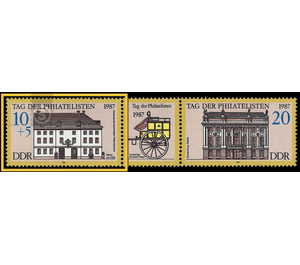Day of the philatelists - Germany / German Democratic Republic 1987 - 10 Pfennig
Theme: Post & Philately
| Country | Germany / German Democratic Republic |
| Issue Date | 1987 |
| Face Value | 10.00 |
| Color | brown |
| Perforation | K 14 |
| Printing Type | Rotogravure 2 |
| Stamp Type | Postage stamp |
| Item Type | Stamp |
| Chronological Issue Number | 2860 |
| Chronological Chapter | GER-DDR |
| SID | 129271 |
| In 20 Wishlists | |
Philatelist Day 1987 On the occasion of the Philatelists' Day in 1987, the Ministry of Posts and Telecommunications of the German Democratic Republic issues two multicolored special postage stamps, one of them with surcharge, in combination with an intermediate box. The surcharge will be made available to the Philatelistenverband in the cultural association of the GDR. Special cancellations from August 11 to October 10, 1987 Philatelic Day 1987 Special postage stamps of the German Democratic Republic to the days of philatelists are a visible expression of close ties and high esteem for the large number of collectors who are members of the Kulturbund of the GDR with postal documents and witnesses. The close interrelations between postal service and philately are confirmed in manifold ways in the German Democratic Republic - whether in the philatelists' concern to devote their exhibits specifically to the representation of postal tasks and concerns from the past and present, be it with the intent of Deutsche Post to promote and support this cultural activity through numerous services. All special postage stamps published so far on the days of philatelists are characterized by this commonality. Their pictorial representations and social statements are always and above all the post-historically interested collectors, so also in the year of the 750th anniversary of the city of Berlin. What was closer than the idea that the general issue of Berlin-based postage stamps in 1987 also emit those that ostensibly document the relationship of the post office to this city. Last but not least, Berlin became the starting point and center of the Brandenburg / Prussian postal system at the beginning of modern times, as the city gradually developed into a court and royal residence right up to the capital. What has been conceived and tested in Berlin since ancient times in the postal sense was ultimately valid for the territory governed by it. On the history of the old Berlin post offices, the way can be traced particularly clearly. Until 1600, the Electoral Brandenburg Botenanstalt was based in the castle to Cölln on the Spree used almost exclusively for state affairs. The first public Berlin post office was located in the former Dechantei of the Cöllner Petrikirche in Brüderstraße 4. This house was given to Berlin's first postmaster, Christoph Frischmann, by the Elector Johann Sigismund as a gift. The central management of the 1649 by the Brandenburg Secret State Council decided state postal service - from 1652 General Post Office - initially remained as a "post office chamber" in Berlin Castle. Under Postmaster Hans Hornemann, the post office in Berlin was relocated in 1662 to the property Heiligegeiststraße 4-5 / Ecke Burgstraße 22. Its unfavorable situation led then 1685 to an exchange with a corner building in the Georgenstraße (starting from 1701 king road 40, today's Marx-Engels-Forum - corner post road 1). The since 1605 resident Joachimthalsche Gymnasium moved to the Heiligegeiststraße. This 3rd Berlin post office - represented on the 10 Pfennig Zuschlag value of the stamp series - received the title of a Hof post office in 1700 and was popularly called the "Alte Post". It remained in operation until 1816. The erratic development of Berlin at the time of early capitalism made it necessary at that time to purchase the properties Königstraße 60 and Spandauer Straße 21, with which the spatial narrowness of the "Alte Post" was to be overcome. Previously, however, the Hof Post Office's grounds had been enlarged by the purchase of the house by Mayor Levin Schardlus to the Spree "At the Long Bridge" in 1701. Here Baumeister Andreas Schlüter built for the only Prussian Erb-General postmaster and favorite of the self-proclaimed Prussian King Frederick I, Kasimir Kolbe Count von Wartenberg, a palace as a representative residence.Wartenberg came to fall in 1712, his palace - represented on the 20-pfennig value of the stamp series - was the seat of the Prussian General Post Office and it also remained until the 1816. The "Alte Post" together with "Palais Wartenberg" went to the merchant Pascal for 70,500 thaler in 1822. In 1889 they fell victim to a public rehabilitation of the pickaxe from the new headquarters of the General Post Office and Hof-Postamt until 1900 gradually the postal complex between Spandauer-, Rathaus-, Heiligegeist- and Kleine Poststraße with Heimstatt de Founded in 1827 Berlin city post office, the telegraph administration, the Berlin letter post office u. a. central facilities. Largely destroyed by Anglo-American bombs in World War II, its irreparable remnants have had to give way to the facilities of the Marx-Engels Forum in the center of Berlin. It has been replaced by new, modern postal facilities in the capital city of Berlin, and its number continues to grow in proportion as the large number of new ones are realized with the realization of the Complex Housing Construction Program as the centerpiece of the Social-Political Program of the VIII Party Congress of the SED Residential areas and the social facilities required for their care are created, these are post offices with state-of-the-art technical equipment in accordance with the requirements of the developed socialist society in the German Democratic Republic.


